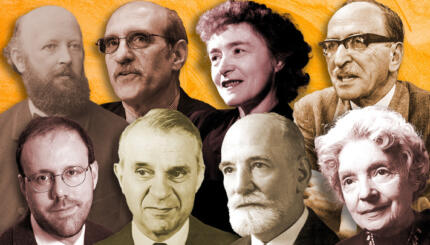Reprinted with permission from the Spring 1997 issue of Reform Judaism.
Jewish American novelists are like Jews themselves–easy to recognize, but difficult to define.
Small wonder then, that many readers associate Jewish American fiction with characters who sport Jewish names and live in largely Jewish neighborhoods, eat lox and bagels at elaborate Sunday brunches, pepper up their conversation by waving their hands and tossing in vivid Yiddish phrases, and suffer from world-class guilt. No longer, for a new group of Jewish American fictionists has emerged, and they don’t have the slightest interest in writing another Portnoy’s Complaint, much less another Exodus or Marjorie Morningstar.
Contemporary Jewish writers such as Steve Stern, Melvin Jules Bukiet, Allegra Goodman, and Rebecca Goldstein bring to the table intelligence, moral passion, magical realism, and perhaps most of all, a Jewish writing no longer skittish about grounding itself in Jewish memory and Jewish ideas. They differ from earlier generations of Jewish novelists who had essentially one story to tell–namely, how they made their way from blue-collar Brooklyn to the glittering, usually assimilated life in Manhattan. Irving Howe once speculated that as the emotional and aesthetic distance from the Jewish immigrant experience widened, we could only look forward to ever-thinner slices of Jewish American social realism; and, as such, that it was probably time to close the book on what he regarded as a rich chapter in the larger history of regional American writing.

Help us keep Jewish knowledge accessible to millions of people around the world.
Your donation to My Jewish Learning fuels endless journeys of Jewish discovery. With your help, My Jewish Learning can continue to provide nonstop opportunities for learning, connection and growth.
Steve Stern
By such reckoning, the stories of Steve Stern ought not to exist. Set in Memphis, Tennessee, at a time when its Jewish ghetto (“the Pinch”) had a distinctive shape and feel, Stern brings to his highly imaginative reconstruction a magical realism that, by crafty increments, transforms the ordinary into the miraculous. The result are stories in which virtually anything can happen–and usually does. Why so? Because “the Pinch” is packed to overflowing with shopkeepers, gossips, no-goodnicks, and inveterate dreamers–all tucked away, as it were, within the folds of a larger Southern culture.
Stern cut his imaginative teeth as a folklorist (in 1983 he served as director of the Center for Southern Folklore’s Ethnic Heritage Program). The oral histories he transcribed as part of his work began to reassemble themselves in his mind. And thus it was that “the Pinch,” in Stern’s words, “rose up like the Lost Continent of Atlantis for me and began to look like a home for my stories.” The result is at once a haunting memory and an intimation of the entirely new–for Stern so blends the surface detail of what was with infusions of the fantastic that it is often difficult to know where accuracy ends and magical realism begins. As one character puts it, “It’s like…being awake in your dreams.”
Melvin Jules Bukiet
|
|
|
Melvin James Bukiet |
If Stern discovered his Jewish milieu largely by happenstance, other writers might argue that they had their fictional territory staked out for them at birth. I am referring to the children of survivors, and especially those writers who bring equal measures of moral passion and unstinting craft to a subject that often perplexed their literary elders into silence. Melvin Jules Bukiet is a case in point. He came to wide attention with Stories of an Imaginary Childhood (1992), a collection set in Proszowice, Poland, about Jews blissfully unaware of the impending catastrophe. Bukiet’s unnamed narrator (he may be Bukiet’s father, a source for many of the stories; Bukiet himself; or, more probably, a combination of the two) introduces himself in a language that seems at once altogether fresh and hauntingly familiar: “Show me a Jewish home without a prodigy and I’ll show you an orphanage.”
What separates the children of survivors from the survivors themselves is that the work of the former is significantly darker than that of their literary progenitors. The older writer, at least, could recollect the world before the cataclysm. For the second generation, however, there is only After, a word that shivers even as it perplexes–and that figures significantly as the title of Bukiet’s recently published novel. As he puts it, in an expression of the new sensibility in perhaps its purest form, “In the beginning was Auschwitz.” Yet, Bukiet does not write about the Holocaust directly. There are no scenes of selection, no gas chambers, no mass graves. Instead, his fiction explores the long shadow of the Shoah. After (St. Martin’s Press) opens at the moment the camps are liberated and follows a group of survivors as they scheme their way through a destroyed, thoroughly chaotic landscape. Bukiet allows his characters the full range of humanity, from the noble to the base, and in the process his vision will surely offend those who have wrapped the subject in such veils of piety that only sanitized portrayals are acceptable.
After drives home its point by assaulting our sense of the tasteful, challenging the notion that decorum could be the same thing “After” as is had been before.
Allegra Goodman
Allegra Goodman’s stories explore the intersections between Judaism and modernity. She concentrates primarily on the Jewish American family, although in ways that make it clear that the Zeitgeist of the 1990s has given the fabled institution some curious, often satiric, spins. With deep roots in the community of observant Jews, the edge of her judgments may be tempered, but that does not mean her satiric eye blinks in the face of hypocrisy.
Readers first met the indomitable Rose Markowitz and her sons Ed and Henry in the pages of Commentary magazine and later between the hard covers of an extraordinary collection of short stories entitled Sudden Immersion (1989). That Allegra Goodman was a Harvard senior at the time took one’s breath away, not only because the stories were so masterfully crafted, but also because they demonstrated prodigious wisdom. Many of the early tales were set in the Hawaii of her childhood, as if she were out to transport the social realism and biting satire of a young Phillip Roth from Newark’s immigrant Jewish suburbs to the unlikely landscape of lanai and lei; but there were also intimations (“Early Variant” is one of them) that Goodman had much wider ambitions. She understands the subtle ways in which academic pretentiousness, contemporary culture, and Jewish Orthodoxy make shaky efforts at coexistence. Most of all, however, Goodman has a knack for creating characters we remember and care about, and she has an endless capacity for human surprise.
Rebecca Goldstein
At first glance, Rebecca Goldstein seems like an older, more intellectual version of Goodman. Her first novel, The Mind-Body Problem (1983), is part academic satire, part meditation on the tension between sexuality and spiritual longing. As her fiction has evolved, Goldstein has focused more on her roots, and like the protagonist who once tried (comically) to shuck off Jewishness only to have it return, it has become an integral, abiding presence.
Born into a traditionally observant Jewish family, Goldstein attended a rigorously Orthodox girls’ for her high school years. She went on to perform distinguished academic work, first at Barnard and then at Princeton, where she completed her Ph.D. in the philosophy of science. Currently she teaches creative writing at Columbia University. Given all this, it is hardly surprising that Goldstein’s typical protagonists tend to be women as long on academic smarts as they are short on confidence and common sense. Mazel (Viking), her latest novel, is no exception, although Sasha, the Saunders family’s eighty-year-old matriarch, gives the old formula some new, unexpected twists. To her daughter, a free-thinking philosopher formed by the sixties, and her granddaughter, Phoebe, a mathematician who specializes in the “geometry of soap bubbles,” Sasha’s stories of how she moved from the restrictions of Old World Orthodoxy to stardom on Warsaw’s pre-war Yiddish stage are as deliciously layered at a Sacher torte; and her no-nonsense, yet abiding love (“You’re so open-minded,” she chides her daughter, Chloe, “that I think your brain must have fallen out!”) not only tells us much about “mazel,” or luck, but also about the ties that bind mothers to daughters, a Jewish past to a Jewish present.
Other writers (among them Tova Reich, Allen Hoffman, Robert Cohen, and Thane Rosenbaum) could easily have been included here. Each is distinctive, but taken together they represent a direction in Jewish American literature that promises to make the next decades at least as rich as the ones that gave us writers such as Saul Bellow, Bernard Malamud, Philip Roth, I.B. Singer, and Cynthia Ozick.



